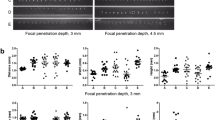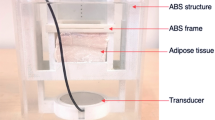Abstract
Non-focused ultrasound and high-intensity focused ultrasound (HIFU) devices induce lipolysis by generating acoustic cavitation and coagulation necrosis in targeted tissues. We aimed to investigate the morphometric characteristics of immediate tissue reactions induced by 2 MHz, 13-mm focused HIFU via two-dimensional ultrasound images and histologic evaluation of cadaveric skin from the abdomen and thigh. Acoustic fields of a 2 MHz, 38-mm HIFU transducer were characterized by reconstruction of the fields using acoustic intensity measurement. Additionally, abdominal and thigh tissues from a fresh cadaver were treated with a HIFU device for a single, two, and three pulses at the pulse energy of 130 J/cm2 and a penetration depth of 13 mm. Acoustic intensity measurement revealed characteristic focal zones of significant thermal injury at the depth of 38 mm. In both the abdomen and thigh tissue, round to oval ablative thermal injury zones (TIZs) were visualized in subcutaneous fat layers upon treatment with a single pulse of HIFU treatment. Two to three HIFU pulses generated larger and more remarkable ablative zones throughout subcutaneous fat layers. Finally, experimental treatment in a tumescent infiltration-like setting induced larger HIFU-induced TIZs of an oval or columnar shape, compared to non-tumescent settings. Although neither acoustic intensity measurement nor cadaveric tissue exactly reflects in vivo HIFU-induced reactions in human tissue, we believe that our data will help guide further in vivo studies in investigating the therapeutic efficacy and safety of HIFU-induced lipolysis.






Similar content being viewed by others
References
Chu KF, Dupuy DE (2014) Thermal ablation of tumours: biological mechanisms and advances in therapy. Nat Rev Cancer 14:199–208
Prentice P, Cuschieri A, Dholakia K, Prausnitz M, Campbell P (2005) Membrane disruption by optically controlled microbubble cavitation. Nat Phys 1:107–110
Bani D, Quattrini Li A, Freschi G, Russo GL (2013) Histological and ultrastructural effects of ultrasound-induced cavitation on human skin adipose tissue. Plast Reconstr Surg Glob Open 1:e41
Shek SY, Yeung CK, Chan JC, Chan HH (2014) Efficacy of high-intensity focused ultrasonography for noninvasive body sculpting in Chinese patients. Lasers Surg Med 46:263–269
Teitelbaum SA, Burns JL, Kubota J, Matsuda H, Otto MJ, Shirakabe Y, Suzuki Y, Brown SA (2007) Noninvasive body contouring by focused ultrasound: safety and efficacy of the Contour I device in a multicenter, controlled, clinical study. Plast Reconstr Surg 120:779–789
Jewell ML, Baxter RA, Cox SE, Donofrio LM, Dover JS, Glogau RG, Kane MA, Weiss RA, Martin P, Schlessinger J (2011) Randomized sham-controlled trial to evaluate the safety and effectiveness of a high-intensity focused ultrasound device for noninvasive body sculpting. Plast Reconstr Surg 128:253–262
Moreno-Moraga J, Valero-Altés T, Riquelme AM, Isarria-Marcosy MI, de la Torre JR (2007) Body contouring by non-invasive transdermal focused ultrasound. Lasers Surg Med 39:315–323
Shek S, Yu C, Yeung CK, Kono T, Chan HH (2009) The use of focused ultrasound for non-invasive body contouring in Asians. Lasers Surg Med 41:751–759
Kim HJ, Kim HG, Zheng Z, Park HJ, Yoon JH, Oh W, Lee CW, Cho SB (2015) Coagulation and ablation patterns of high-intensity focused ultrasound on a tissue-mimicking phantom and cadaveric skin. Lasers Med Sci 30:2251–2258
Zhou Y, Zhai L, Simmons R, Zhong P (2006) Measurement of high intensity focused ultrasound fields by a fiber optic probe hydrophone. J Acoust Soc Am 120:676–685
Wang M, Zhou Y (2016) Simulation of non-linear acoustic field and thermal pattern of phased-array high-intensity focused ultrasound (HIFU). Int J Hyperth 32:569–582
Jensen JA, Rasmussen MF, Pihl MJ, Holbek S, Hoyos CA, Bradway DP, Stuart MB, Tomov BG (2016) Safety assessment of advanced imaging sequences I: measurements. IEEE Trans Ultrason Ferroelectr Freq Control 63:110–119
Jewell ML, Desilets C, Smoller BR (2011) Evaluation of a novel high-intensity focused ultrasound device: preclinical studies in a porcine model. Aesthet Surg J 31:429–434
Franco W, Kothare A, Ronan SJ, Grekin RC, McCalmont TH (2010) Hyperthermic injury to adipocyte cells by selective heating of subcutaneous fat with a novel radiofrequency device: feasibility studies. Lasers Surg Med 42:361–370
Klein JA (1987) The tumescent technique for liposuction surgery. Am J Cosmet Surg 4:263–267
Wang G, Cao W (2011) Tumescent liposuction: partitioning of lidocaine at a lower dose (252 mg/l). Dermatology 222:274–277
Suh DH, Choi JH, Lee SJ, Jeong KH, Song KY, Shin MK (2015) Comparative histometric analysis of the effects of high-intensity focused ultrasound and radiofrequency on skin. J Cosmet Laser Ther 24:1–7
Acknowledgements
We would like to thank Anthony Thomas Milliken, ELS (Editing Synthase, Seoul, Korea) for his help with the editing of this manuscript.
Author information
Authors and Affiliations
Corresponding author
Ethics declarations
All authors were well informed of the WMA Declaration of Helsinki (Ethical Principles for Medical Research Involving Human Subjects) and confirmed that the present study firmly fulfilled the declaration. The cadaveric subject in this study was legally donated to Yonsei Medical Center.
Informed consent
Not applicable.
Conflict of interest
The authors declare that they have no conflict of interest.
Funding sources
None.
Rights and permissions
About this article
Cite this article
Lee, S., Kim, HJ., Park, H.J. et al. Morphometric analysis of high-intensity focused ultrasound-induced lipolysis on cadaveric abdominal and thigh skin. Lasers Med Sci 32, 1143–1151 (2017). https://doi.org/10.1007/s10103-017-2220-z
Received:
Accepted:
Published:
Issue Date:
DOI: https://doi.org/10.1007/s10103-017-2220-z




